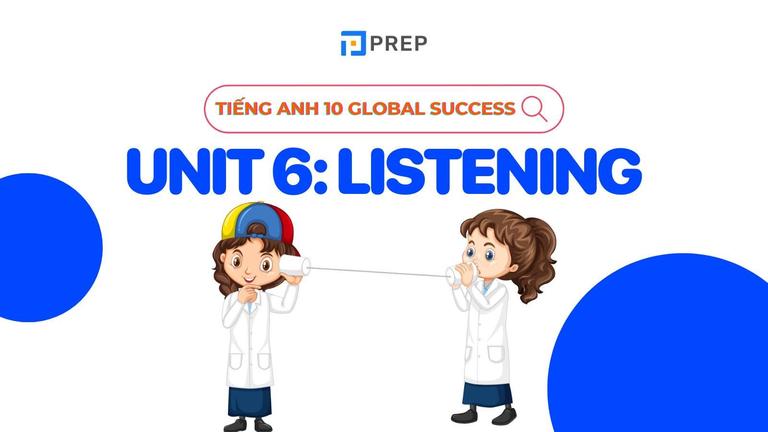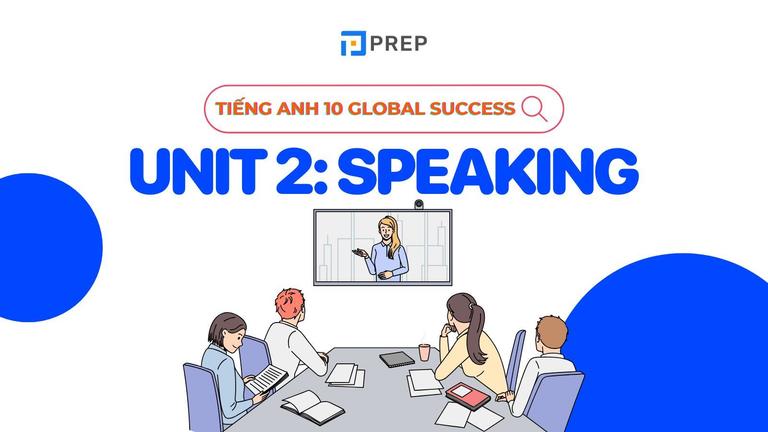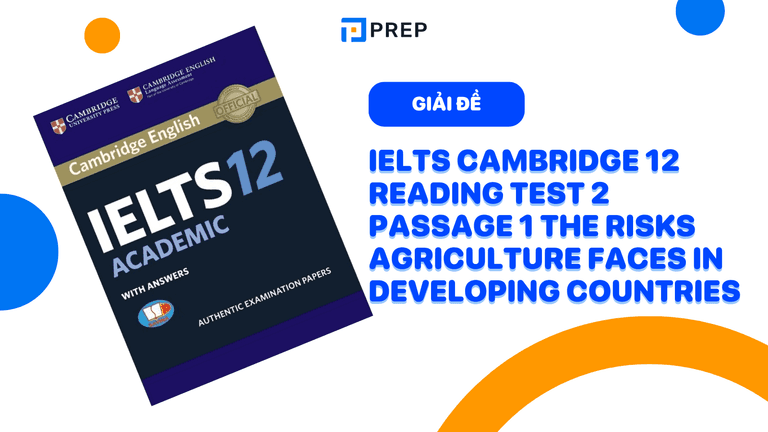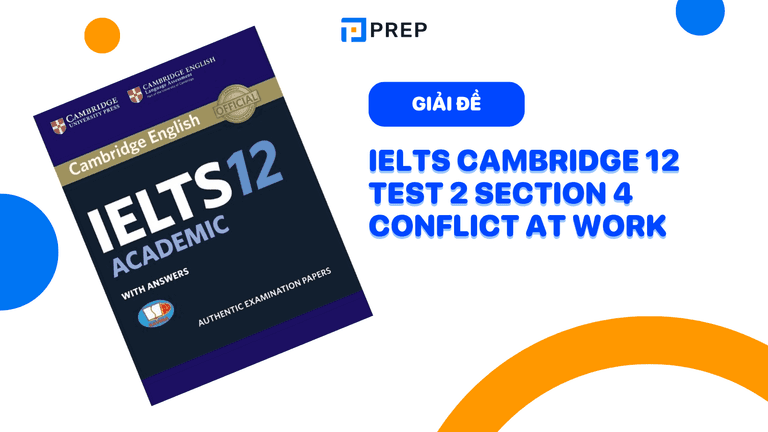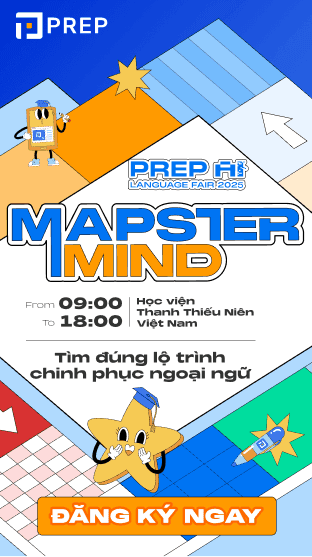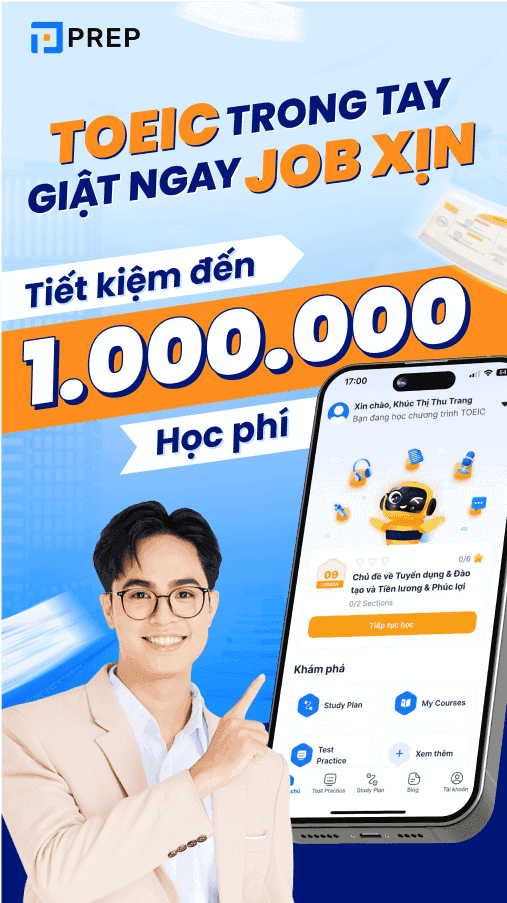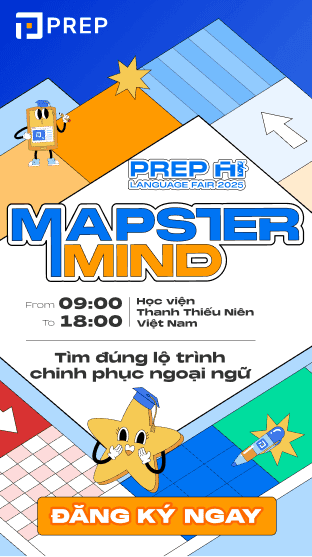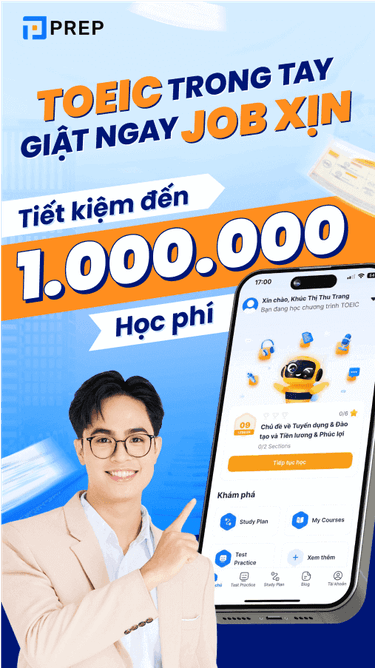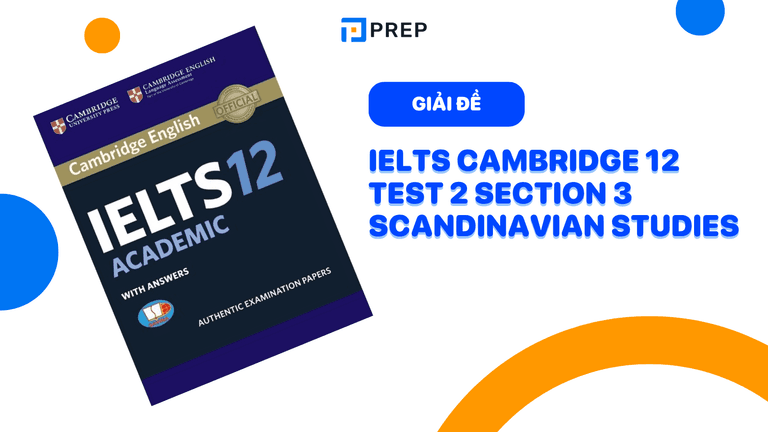Đề bài và đáp án chi tiết IELTS Cambridge 12 Reading Test 2 passage 2 The Lost City
Bài đọc IELTS Cambridge 12 Reading Test 2 Passage 2 có tiêu đề The Lost City, xoay quanh việc khám phá một thành phố bị lãng quên trong lịch sử và hành trình nghiên cứu của các nhà khảo cổ học. Đây là dạng bài đọc học thuật đòi hỏi khả năng hiểu bối cảnh lịch sử, nhận diện thông tin chi tiết và phân tích lập luận trong bài. Trong bài viết sau, Prep sẽ tổng hợp đề bài, cung cấp đáp án đầy đủ cùng phần giải thích chi tiết giúp bạn hiểu rõ cách tìm thông tin, cách đối chiếu từ khóa và chiến thuật làm bài hiệu quả nhất. Qua đó, bạn sẽ tăng khả năng đọc hiểu, cải thiện kỹ năng tìm ý và xử lý các dạng câu hỏi thường gặp trong phần thi IELTS Reading.
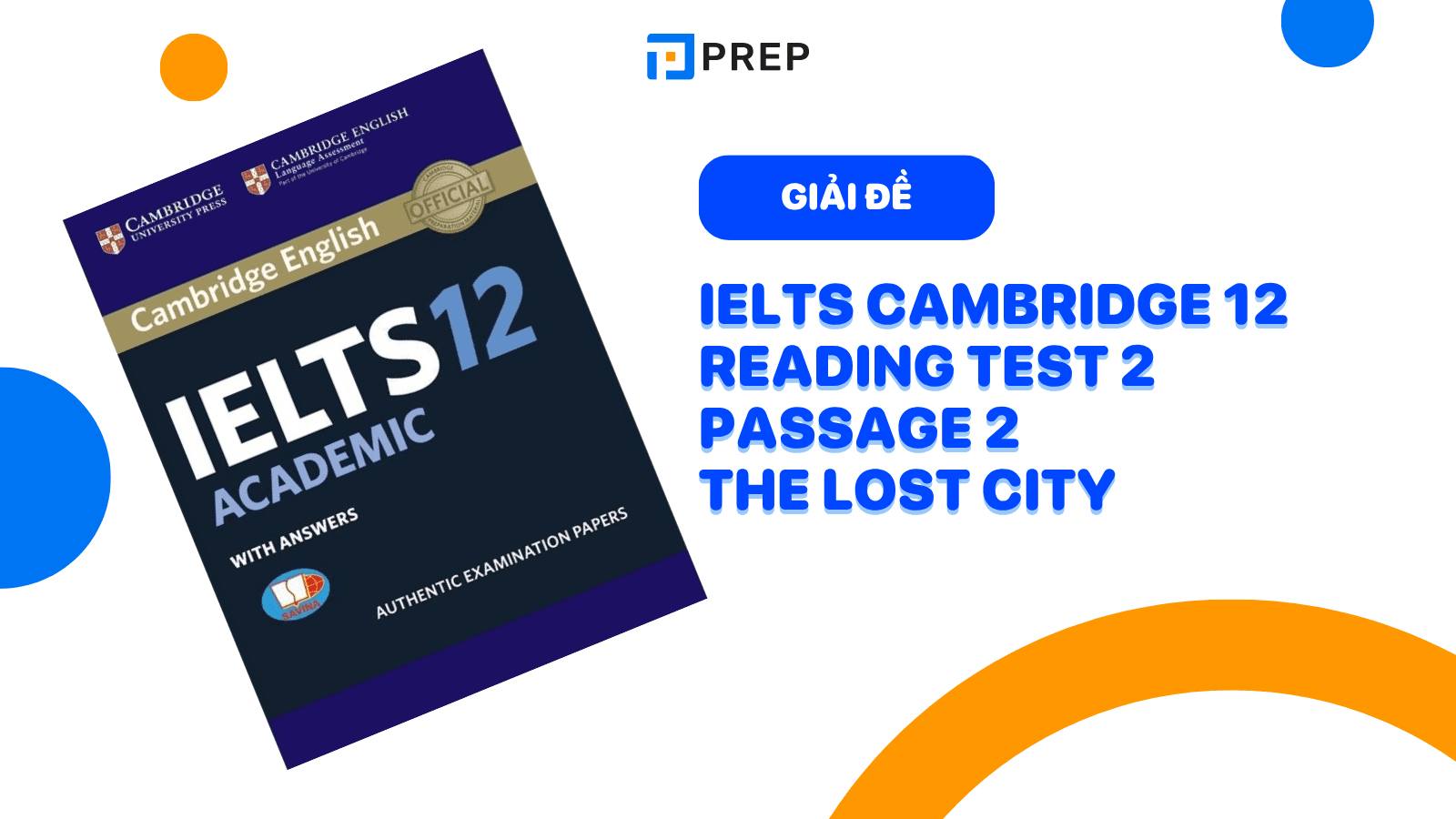
I. Đề bài IELTS Cambridge 12 Reading Test 2 passage 2 The Lost City
Đọc kỹ đề bài IELTS Cambridge 12 Reading Test 2 passage 2 The Lost City:
Reading The Lost City
An explorer’s encounter with the ruined city of Machu Picchu, the most famous icon of the Inca civilisation
A. When the US explorer and academic Hiram Bingham arrived in South America in 1911, he was ready for what was to be the greatest achievement of his life: the exploration of the remote hinterland to the west of Cusco, the old capital of the Inca empire in the Andes mountains of Peru. His goal was to locate the remains of a city called Vitcos, the last capital of the Inca civilisation. Cusco lies on a high plateau at an elevation of more than 3,000 metres, and Bingham’s plan was to descend from this plateau along the valley of the Urubamba river, which takes a circuitous route down to the Amazon and passes through an area of dramatic canyons and mountain ranges.
B. When Bingham and his team set off down the Urubamba in late July, they had an advantage over travellers who had preceded them: a track had recently been blasted down the valley canyon to enable rubber to be brought up by mules from the jungle. Almost all previous travellers had left the river at Ollantaytambo and taken a high pass across the mountains to rejoin the river lower down, thereby cutting a substantial corner, but also therefore never passing through the area around Machu Picchu.
C. On 24 July they were a few days into their descent of the valley. The day began slowly, with Bingham trying to arrange sufficient mules for the next stage of the trek. His companions showed no interest in accompanying him up the nearby hill to see some ruins that a local farmer, Melchor Arteaga, had told them about the night before. The morning was dull and damp, and Bingham also seems to have been less than keen on the prospect of climbing the hill. In his book Lost City of the Incas, he relates that he made the ascent without having the least expectation that he would find anything at the top.
D. Bingham writes about the approach in vivid style in his book. First, as he climbs up the hill, he describes the ever-present possibility of deadly snakes, ‘capable of making considerable springs when in pursuit of their prey’; not that he sees any. Then there’s a sense of mounting discovery as he comes across great sweeps of terraces, then a mausoleum, followed by monumental staircases and, finally, the grand ceremonial buildings of Machu Picchu. ‘It seemed like an unbelievable dream … the sight held me spellbound …’ he wrote.
E. We should remember, however, that Lost City of the Incas is a work of hindsight, not written until 1948, many years after his journey. His journal entries of the time reveal a much more gradual appreciation of his achievement. He spent the afternoon at the ruins noting down the dimensions of some of the buildings, then descended and rejoined his companions, to whom he seems to have said little about his discovery. At this stage, Bingham didn't realise the extent or the importance of the site, nor did he realise what use he could make of the discovery.
F. However, soon after returning it occurred to him that he could make a name for himself from this discovery. When he came to write the National Geographic magazine article that broke the story to the world in April 1913, he knew he had to produce a big idea. He wondered whether it could have been the birthplace of the very first Inca, Manco the Great, and whether it could also have been what chroniclers described as 'the last city of the Incas'. This term refers to Vilcabamba, the settlement where the Incas had fled from Spanish invaders in the 1530s. Bingham made desperate attempts to prove this belief for nearly 40 years. Sadly, his vision of the site as both the beginning and end of the Inca civilisation, while a magnificent one, is inaccurate. We now know that Vilcabamba actually lies 65 kilometres away in the depths of the jungle.
G. One question that has perplexed visitors, historians and archaeologists alike ever since Bingham, is why the site seems to have been abandoned before the Spanish Conquest. There are no references to it by any of the Spanish chroniclers – and if they had known of its existence so close to Cusco they would certainly have come in search of gold. An idea which has gained wide acceptance over the past few years is that Machu Picchu was a moya, a country estate built by an Inca emperor to escape the cold winters of Cusco, where the elite could enjoy monumental architecture and spectacular views. Furthermore, the particular architecture of Machu Picchu suggests that it was constructed at the time of the greatest of all the Incas, the emperor Pachacuti (c. 1438–71). By custom, Pachacuti's descendants built other similar estates for their own use, and so Machu Picchu would have been abandoned after his death, some 50 years before the Spanish Conquest.
You should spend about 20 minutes on Questions 14-26, which are based on Reading Passage 2 below.
Questions 14-20
Reading Passage 2 has seven paragraphs, A-G.
Choose the correct heading for each paragraph from the list of headings below.
Write the correct number, i-viii, in boxes 14-20 on your answer sheet.
List of Headings
i Different accounts of the same journey
ii Bingham gains support
iii A common belief
iv The aim of the trip
v A dramatic description
vi A new route
vii Bingham publishes his theory
viii Bingham's lack of enthusiasm
14 Paragraph A
15 Paragraph B
16 Paragraph C
17 Paragraph D
18 Paragraph E
19 Paragraph F
20 Paragraph G
Questions 21-24
Do the following statements agree with the information given in Reading Passage 2?
In boxes 21-24 on your answer sheet, write
TRUE if the statement agrees with the information
FALSE if the statement contradicts the information
NOT GIVEN if there is no information on this
21 Bingham went to South America in search of an Inca city.
22 Bingham chose a particular route down the Urubamba valley because it was the most common route used by travellers.
23 Bingham understood the significance of Machu Picchu as soon as he saw it.
24 Bingham returned to Machu Picchu in order to find evidence to support his theory.
Questions 25-26
Complete the sentences below.
Choose ONE WORD ONLY from the passage for each answer.
Write your answers in boxes 25-26 on your answer sheet.
25 The track that took Bingham down the Urubamba valley had been created for the transportation of ...................... .
26 Bingham found out about the ruins of Machu Picchu from a ...................... in the Urubamba valley.

II. Đáp án bài đọc IELTS Cambridge 12 Reading Test 2 passage 2 The Lost City
Đáp án bài đọc IELTS Cambridge 12 Reading Test 2 passage 2 The Lost City:
Reading Passage 2, Questions 14-26
-
iv
-
vi
-
viii
-
v
-
i
-
vii
-
iii
-
TRUE
-
FALSE
-
FALSE
-
NOT GIVEN
-
rubber
-
farmer
III. Đáp án chi tiết bài đọc IELTS Cambridge 12 Reading Test 2 passage 2 The Lost City
Tham khảo đáp án chi tiết dưới đây để nắm rõ cách xử lý từng dạng câu hỏi trong bài đọc nhé!
Questions 14–20: Matching Headings
|
Câu |
Đáp án |
Giải thích |
|
14 |
iv |
Paragraph A nói ngay mục tiêu chuyến đi: tìm “Vitcos, the last capital of the Inca civilisation” → The aim of the trip. |
|
15 |
vi |
Paragraph B nói về “a track recently blasted” tạo route mới thay vì đường cũ → A new route. |
|
16 |
viii |
Paragraph C: Bingham “less than keen”, “no expectation” → thiếu nhiệt tình → Bingham's lack of enthusiasm. |
|
17 |
v |
Paragraph D mô tả cảnh rất “vivid style”, cảm xúc mạnh → A dramatic description. |
|
18 |
i |
Paragraph E: đối chiếu nhật ký lúc đó và sách viết lại sau này → Different accounts of the same journey. |
|
19 |
vii |
Paragraph F: Ông viết bài National Geographic để công bố lý thuyết → Bingham publishes his theory. |
|
20 |
iii |
Paragraph G nói về giả thuyết Machu Picchu bị bỏ hoang, “a moya” → niềm tin phổ biến → A common belief. |
Questions 21–24: TRUE / FALSE / NOT GIVEN
|
Câu |
Đáp án |
Giải thích |
|
21 |
TRUE |
A: “His goal was to locate the remains of a city” → đúng mục đích tìm thành phố Inca. |
|
22 |
FALSE |
B: route này mới, còn người trước “took a high pass ... cutting a corner” → không phải đường phổ biến. |
|
23 |
FALSE |
E: ban đầu “didn't realise the extent or importance” → không hiểu ngay. |
|
24 |
NOT GIVEN |
Không có câu nào nói ông trở lại Machu Picchu để tìm bằng chứng. Có nói ông tìm chứng cứ nhiều năm, nhưng không nhắc việc quay lại. |
Questions 25–26: Sentence Completion
|
Câu |
Đáp án |
Giải thích |
|
25 |
rubber |
B: “track... to enable rubber to be brought up” |
|
26 |
farmer |
C: “a local farmer, Melchor Arteaga, had told them” |
IV. Từ vựng hay trong bài nên ghi nhớ
Take note nhanh các từ vựng hay trong bài sau đây để mở rộng vốn từ:
|
Từ vựng |
Dịch nghĩa |
Ví dụ |
|
hinterland |
vùng nội địa xa xôi |
They explored the remote hinterland beyond the mountains. (Họ khám phá vùng nội địa xa xôi sau dãy núi.) |
|
circuitous route |
lộ trình vòng vèo |
He took a circuitous route to avoid the main road. (Anh ấy đi đường vòng để tránh đường chính.) |
|
ascent |
sự leo lên |
The ascent to the ruins was steep and exhausting. (Việc leo lên khu tàn tích rất dốc và mệt.) |
|
mausoleum |
lăng mộ |
The ancient mausoleum contained royal remains. (Lăng cổ chứa di hài hoàng gia.) |
|
spellbound |
bị mê hoặc, cuốn hút |
He stood spellbound before the ancient city. (Anh đứng sững, bị mê hoặc trước thành phố cổ.) |
|
hindsight |
nhìn lại sau này |
With hindsight, he realised his discovery’s importance. (Nhìn lại, anh mới hiểu tầm quan trọng phát hiện của mình.) |
|
chronicler |
người ghi chép lịch sử |
The chronicler recorded the empire’s final days. (Người biên niên sử ghi chép những ngày cuối đế chế.) |
|
perplex |
gây bối rối |
The mystery continues to perplex archaeologists. (Bí ẩn tiếp tục gây bối rối cho các nhà khảo cổ.) |
|
architecture |
kiến trúc |
The architecture of the site was impressive. (Kiến trúc của khu này rất ấn tượng.) |
|
descendants |
hậu duệ |
His descendants continued the tradition. (Hậu duệ của ông tiếp tục truyền thống.) |

Trên đây là đề bài và đáp án chi tiết bài đọc IELTS Cambridge 12 Reading Test 2 Passage 2. Hy vọng tài liệu trên sẽ hữu ích cho bạn trong quá trình luyện thi IELTS.
Học tiếng Anh online dễ dàng hơn với PREP - Nền tảng Học & Luyện thi thông minh cùng AI. Nhờ công nghệ AI độc quyền, bạn có thể tự học trực tuyến ngay tại nhà, chinh phục lộ trình học IELTS, TOEIC, tiếng Anh giao tiếp hiệu quả. Bên cạnh đó, học viên còn có sự hỗ trợ tuyệt vời từ Teacher Bee AI, trợ lý ảo giúp bạn giải đáp thắc mắc và đồng hành 1-1 trong suốt quá trình học tập. Hãy click TẠI ĐÂY hoặc liên hệ HOTLINE 0931428899 để nhận tư vấn chi tiết về các khóa học tiếng Anh chất lượng nhất thị trường!
Tải ngay app PREP để bắt đầu hành trình học tiếng Anh tại nhà với chương trình học luyện thi online chất lượng cao.

Chào bạn! Mình là Hiền Hoàng, hiện đang đảm nhận vai trò quản trị nội dung sản phẩm tại Blog của website prepedu.com.
Với hơn 5 năm tự học các ngoại ngữ như tiếng Anh, tiếng Trung và ôn luyện một số kỳ thi IELTS, TOEIC, HSK, mình đã tự đúc rút được nhiều kinh nghiệm để hỗ trợ hàng nghìn người đang gặp khó khăn trong việc học ngoại ngữ. Hy vọng rằng những chia sẻ phía trên sẽ giúp ích cho bạn trong quá trình tự ôn luyện thi hiệu quả tại nhà!
Bình luận
Nội dung premium
Xem tất cảLộ trình cá nhân hoá
Có thể bạn quan tâm
Kết nối với Prep

MSDN: 0109817671.
Địa chỉ liên hệ: Tòa nhà Vinaconex, 34 Láng Hạ, phường Láng, TP Hà Nội.
Địa chỉ kinh doanh: Lô 21 C2 Khu đô thị Nam Trung Yên, phường Yên Hòa, TP Hà Nội.
Trụ sở: Số nhà 20, ngách 234/35 đường Hoàng Quốc Việt, phường Nghĩa Đô, TP Hà Nội.
Phòng luyện ảo - Trải nghiệm thực tế - Công nghệ hàng đầu.
Hotline: 0931 42 8899.
Trụ sở: Số nhà 20, ngách 234/35 đường Hoàng Quốc Việt, phường Nghĩa Đô, TP Hà Nội.
Giấy chứng nhận hoạt động đào tạo, bồi dưỡng số 1309/QĐ-SGDĐT ngày 31 tháng 07 năm 2023 do Sở Giáo dục và Đào tạo Hà Nội cấp.
